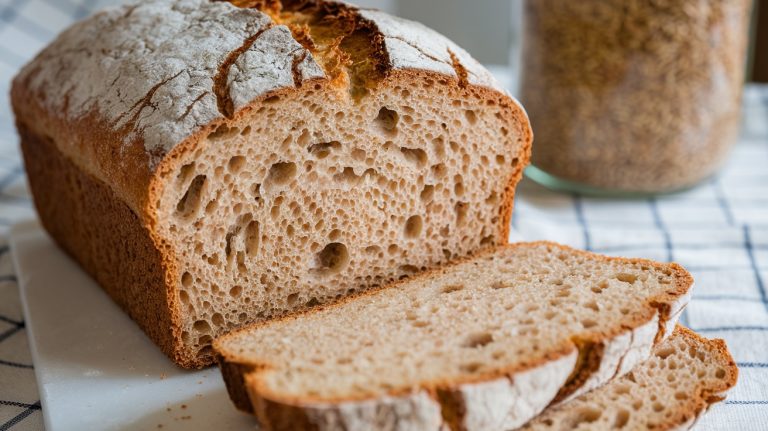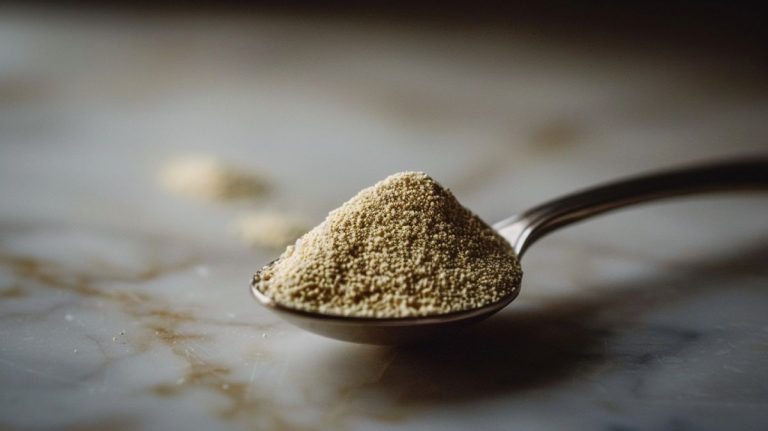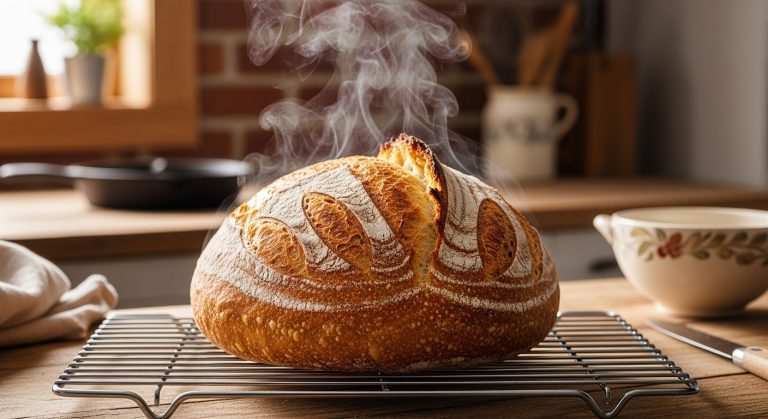Sourdough Croissants: Layer by Layer, Discover the Magic
Sourdough croissants offer a delightful combination of flaky texture and tangy flavor from natural leavening. You’ll mix high-quality flour, a vibrant sourdough starter, and cold butter to create a soft, elastic dough.
After initial fermentation, you’ll meticulously fold and laminate the dough, layering it with cool butter for those signature airy layers. Finally, bake until golden brown for a perfect brunch treat.
Discover the essential tips and techniques to master this indulgent pastry ahead.
Key Takeaways
- Use a high-quality sourdough starter for natural leavening and enhanced flavor in your croissants.
- Incorporate cold butter during lamination to create flaky layers and maintain texture.
- Allow for a long fermentation period, ideally overnight in the fridge, for better flavor and a lighter crumb.
- Control dough temperature to prevent butter from melting during lamination; aim for a cool, pliable consistency.
- Store croissants in an airtight container for up to three days or freeze for longer preservation.
Ingredients and Supplies
When you commence the journey of making sourdough croissants, it’s essential to gather the right ingredients and supplies to guarantee success.
Begin with high-quality flour; all-purpose yields a softer texture, while bread flour offers structure. A good sourdough starter is fundamental for natural leavening and depth of flavor. Don’t forget sugar for sweetness and browning, and salt to enhance flavor and control fermentation.
Unsalted butter, ideally with over 80% fat, creates those irresistible flaky layers. Additionally, the use of slow fermentation in the recipe contributes to a rich, complex taste that elevates the overall flavor profile. The choice of flour can significantly impact the crumb structure and texture of your croissants due to its protein content.
For supplies, a stand mixer simplifies dough mixing, while a pastry wheel helps cut your dough into perfect triangles. A ruler guarantees even rolling, and parchment paper is critical for chilling your butter block.
Preparation Process
As you gather your ingredients for sourdough croissants, remember that each one plays an essential role in the final flavor and texture. Mixing techniques are important; you’ll want to achieve a smooth, elastic dough that sets the stage for ideal fermentation.
Don’t underestimate the significance of fermentation time, as it transforms your dough, allowing those complex flavors to develop beautifully.
Ingredient Selection Essentials
Selecting the right ingredients is essential for mastering sourdough croissants, as each component plays a vital role in achieving the perfect balance of flavor and texture.
Start with high-quality flour; bread flour offers the strongest gluten structure, while a blend with all-purpose flour can yield a delightful softness. Your sourdough starter should be at peak activity, infusing tanginess and natural leavening, which is crucial for longer fermentation processes.
Choose European-style butter for its high-fat content—this is key for creating those flaky layers. For hydration, combine water and milk, with milk adding a rich depth.
Don’t forget salt to enhance flavor and strengthen gluten, and a touch of sugar for that beautiful golden crust. Each ingredient matters in your quest for perfection.
Dough Mixing Techniques
Mastering the dough mixing techniques for sourdough croissants is essential to achieving that coveted flakiness and rich flavor.
Start by combining all-purpose flour, sourdough starter, milk, sugar, and salt in a stand mixer. Mix on low speed until the ingredients come together.
Next, incorporate cold butter and continue mixing for 10-12 minutes until the dough is smooth and elastic. Aim for a slightly sticky, shiny consistency. It’s important to use an active sourdough starter as it adds tang and leavens the dough without yeast.
Here are key steps to keep in mind:
- Use a stand mixer for thorough mixing.
- Knead manually if needed until smooth and tacky.
- Let the dough rest in a greased bowl.
- Make certain the butter remains cold during lamination.
- Maintain a clean, cool work surface for best results.
Fermentation Time Importance
Understanding the importance of fermentation time is vital for achieving the perfect sourdough croissant. The initial fermentation, lasting about four hours at 75°F to 78°F, activates your sourdough starter, breaking down sugars and developing flavor. This longer fermentation time allows for a more open honeycomb interior and a slightly sour flavor.
After this, refrigerating the dough overnight slows fermentation, enhancing taste and making it easier to handle. This cold fermentation is essential for creating those flaky layers you crave.
Remember, you can adjust fermentation times based on your schedule; flexibility is key. A longer fermentation enhances gluten breakdown, contributing to a light texture and complex flavor, while precise temperature control during proofing guarantees your croissants rise beautifully.
Lamination and Folding
As you begin the journey of creating perfect sourdough croissants, the lamination and folding process becomes your secret weapon for achieving those coveted flaky layers.
Mastering this technique is essential, and here are key practices to keep in mind:
- Temperature Control: Keep the dough and butter cool to prevent melting.
- Butter Consistency: Use cold but pliable butter for ideal layering.
- Folding Technique: Employ the letter fold to create distinct layers.
- Refrigeration: Chill the dough between folds to maintain butter integrity.
- Gentle Rolling: Roll the dough gently to guarantee even distribution of butter.
Baking and Finishing
Once you’ve meticulously shaped and proofed your sourdough croissants, the baking and finishing process transforms your labor into a golden masterpiece.
Preheat your oven to 425°F (218°C) for 30 minutes, then reduce it to 400°F (204°C) as you place the croissants inside. Bake for 10 minutes, then rotate and switch pans, continuing for another 10-15 minutes until they achieve a shiny, dark brown top. For an even bake, lower the temperature to 375°F after the first 3 minutes.
Before baking, gently brush the croissants with an egg wash made from egg yolk and milk, ensuring a glossy finish. The use of natural leavening in sourdough croissants contributes to their complex flavor profile.
Once baked, cool them on wire racks to maintain that flaky, tender texture. Enjoy your creation!
Variations and Additions

While classic sourdough croissants are a delight on their own, experimenting with variations and additions can elevate your baking to new heights.
Consider these enticing options to infuse your croissants with unique flavors and textures:
- Herbal Flavors: Add rosemary or thyme for a savory twist. Incorporating high-quality flour options can also enhance the overall texture of your croissants.
- Nutty Flavors: Fold in ground almonds or hazelnuts for depth. Sourdough croissants can have a delightful crunch when nuts are included.
- Cheese Additions: Sprinkle Gruyère or Parmesan between layers for richness.
- Chocolate Additions: Transform the dough with cocoa powder for decadence.
- Savory Fillings: Try ham and cheese or spinach and feta for savory satisfaction.
Tips and Considerations
When preparing sourdough croissants, attention to detail can make all the difference in achieving the perfect flaky texture and rich flavor.
Start with an active sourdough starter; it’s vital for that deep, complex taste. Opt for high-quality European-style butter—its higher fat content guarantees those delightful layers. Additionally, remember that sourdough fermentation involves both yeast and bacteria, which can affect the dough’s overall flavor profile. The ideal hydration level of 70-80% can also contribute to a lighter croissant.
Remember, the dough and butter must remain cold during lamination. Use the letter fold technique, allowing for 3-4 folds with adequate resting between each to maintain the integrity of your layers.
Proof at room temperature until the dough doubles, avoiding overproofing to keep that ideal texture. Be mindful that opening the oven door during baking can disrupt the heat and lead to uneven results.
Finally, chill the croissants before baking to prevent butter leakage, and don’t skip the egg wash for a beautifully golden finish.
Troubleshooting Common Issues
Troubleshooting common issues with sourdough croissants can save your baking endeavors from becoming a frustrating experience.
Here’s a quick guide to address frequent problems:
- Overproofing can lead to flat croissants; aim for 2 to 3 hours of proofing.
- Underproofing may cause butter leakage and a gummy texture. To avoid this, consider experimenting with a 40% starter for improved fermentation speed.
- Keep butter cool during lamination to prevent melting into the dough.
- Avoid over-kneading; it creates excess gluten, making the dough prone to tearing.
- Confirm proper folding techniques for uniform layers.
Serving Suggestions
How can you elevate your dining experience with sourdough croissants? These versatile pastries can transform any meal. For breakfast, imagine flaky croissant waffles or a decadent French toast casserole. At brunch, create elegant sandwiches or savory croissant strata.
For dessert, indulge in chocolate-dipped croissants or creamy pastries. Pairing these treats with a warm beverage can enhance the experience, especially given that a ready starter should double or triple in size.
Here’s a quick reference table for your serving suggestions:
| Meal Type | Suggestions | Pairings |
|---|---|---|
| Breakfast | French Toast Casserole | Fresh Fruit |
| Brunch | Croissant Strata | Quiche |
| Dessert | Cream-Filled Croissants | Whipped Cream |
| Holidays | Croissant Wreaths | Cheese Platter |
| Snacks | Cinnamon Sugar Croissants | Coffee |
Storage Tips
To keep your sourdough croissants fresh and delicious, it’s essential to understand the best storage practices.
Start by storing them in an air-tight container at room temperature for up to three days, preferably in a cool, dark place. If you need to keep them longer, consider freezing them. Sourdough bread stays fresh for 4-5 days, so it’s crucial to consume or freeze them before they lose quality.
Here are some tips to guarantee peak storage:
- Wrap croissants tightly in plastic wrap before placing them in a freezer bag.
- Store frozen croissants for up to two months.
- Thaw on the counter or in the refrigerator overnight.
- Reheat in an oven or toaster oven to regain crispiness.
- Avoid moisture to prevent sogginess and maintain that delightful texture.
Frequently Asked Questions
How Long Does It Take to Make Sourdough Croissants From Start to Finish?
Making sourdough croissants takes about two days from start to finish.
You’ll spend around five days creating a sourdough starter, then dedicate approximately 12-14 hours for the dough preparation and fermentation.
Once that’s done, the lamination process and shaping will take several hours, followed by proofing for about five hours.
Finally, you’ll bake them for around 23 minutes.
Patience is key, but the delicious results are well worth the wait!
Can I Freeze Sourdough Croissants Before or After Baking?
You can freeze croissants both before and after baking.
Imagine the delight of enjoying fresh, flaky pastries straight from the oven, contrasting with the convenience of having them ready at a moment’s notice.
If you freeze unbaked croissants, they’ll need time to thaw and proof before baking.
Baked ones, wrapped tightly, can be reheated easily, bringing back that warm, buttery goodness.
Either way, you’re preserving moments of indulgence for later enjoyment.
What Equipment Do I Need to Make Sourdough Croissants?
To make perfect pastries, you’ll need essential tools like a baking scale for accurate measurements and a stand mixer for effective mixing.
A rolling pin helps you roll out dough evenly, while a ruler guarantees consistent lamination.
Don’t forget a pastry brush for applying egg wash and a bench scraper for shaping.
The parchment paper keeps your baking sheets clean, and cooling racks prevent sogginess after baking.
These tools will elevate your pastry-making experience!
How Do I Know if My Sourdough Starter Is Active Enough?
To know if your sourdough starter’s active enough, look for signs of life and energy. It should rise dramatically, doubling or tripling in size.
Bubbles dance on the surface, hinting at fermentation’s magic. A pleasant, tangy aroma replaces any unpleasant scents.
When you drop a spoonful in water, it should float confidently, showcasing its readiness.
Can I Use Whole Wheat Flour Instead of All-Purpose Flour?
You can definitely use whole wheat flour instead of all-purpose flour, but expect some differences in texture and flavor.
Whole wheat flour tends to create denser baked goods due to its coarser grind. To achieve a lighter result, consider mixing whole wheat and all-purpose flour.
Remember, proper gluten development and careful rolling techniques are essential to maintain structure and flakiness.
‘Layers of love’: Perfect Sourdough Croissants!
You’ve mastered the art of sourdough croissants, and who knew playing with dough could be this rewarding? After all those intricate folds and layers, you might just find that your kitchen has transformed into a French patisserie—minus the beret and baguette!
As you savor the flaky, tangy goodness of your creation, remember: these croissants may take time, but they’re worth every minute. So, go ahead, and impress your friends with your newfound pastry prowess (and don’t mention the mess).







